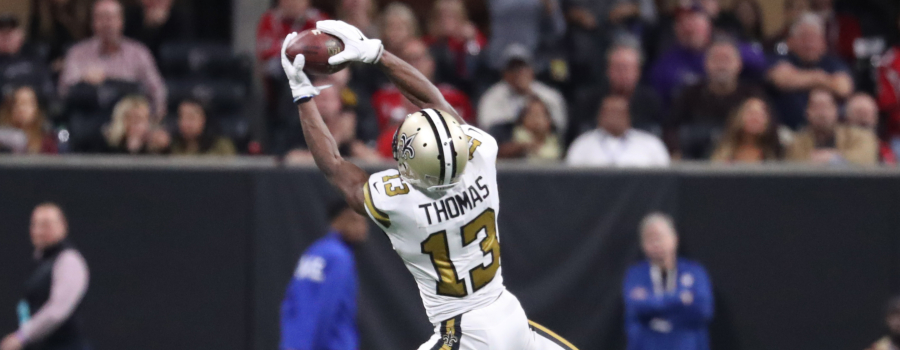In the weekly Fantasy Trends, we leverage the Trends tool to find quarterbacks, wide receivers and running backs with notable data points for the upcoming main slate. For more of our weekly football content, visit our NFL homepage.
A few weeks ago, I analyzed wide receiver production to identify the kinds of wide receivers who have benefited the most from 2018’s passing revolution. Now midway through the season, we have a much more robust sample size of receiving data, so I’m diving even deeper into current receiving production using advanced metrics to identify DFS value options with low ownership.
To examine this, I evaluated wide receivers based on seven advanced metrics: Air Yards, Air Yards Team Market Share, Target Share, Average Depth of Target, Yards After Catch, Receiver Air Conversion Ratio and Weighted Opportunity Rating. The first four of those statistics convey a receiver’s volume, depth and quality of pass opportunities. The latter three describe a receiver’s efficiency and productiveness when targeted.
A lot of credit for these advanced metrics goes to Josh Hermsmeyer of airyards.com. A more in-depth breakdown of air yards and related statistics can be found here and here.
I have also reproduced definitions for each of our seven advanced metrics below:
Air Yards (AY) – Total receiving yards intended, including both complete and incomplete pass targets.
Air Yards Team Market Share (AY MS) – The percentage of a team’s air yards that a player commands based on his average depth of target and volume of targets.
Team Target Share (TS) – A percentage describing how frequently a player is targeted on his team.
Average Depth of Target (aDOT) – Developed by Mike Clay of ESPN, this metric is computed by dividing air yards by targets. It reveals how deep a receiver ran his routes and how many air yards he saw per target on average.
Yards After Catch (YAC) – Total yards gained after making a reception. A player’s total receiving yards may be thought of as the sum of his completed air yards and yards after catch.
Receiver Air Conversion Ratio (RACR) – A ratio dividing receiving yards by total air yards. This metric describes a player’s receiving efficiency, answering the question: “At the depth of target a player is targeted the most, how efficient is he?”
Weighted Opportunity Rating (WOPR) – A rating that takes share of team air yards and share of team targets and weights them based on how well they predict PPR fantasy points. Targets are given roughly twice as much weight as air yards, and when you combine the two, you are able to more accurately assess the opportunity a receiver is commanding.
Wide Receiver Advanced Metrics Percentile Ranks
Below you will find percentile ranks for all qualifying wide receivers in our sample according to each metric listed above. In general, higher percentile rank correlates with better fantasy production. But there is one exception: Average Depth of Target (aDOT) tends to describe a receiver’s role in the offense rather than the quality of his opportunities.
So, a receiver with a higher aDOT percentile rank is targeted on average farther downfield, whereas players with lower aDOT percentile ranks are targeted closer to the line of scrimmage.
Results
For my discussion of each of our metrics, I’ve broken down our sample into quartiles. Quartiles separate a sample population into four equal groups. In our case, those four quartiles are separated based on percentile rank rather than raw number of individuals.
In the following discussion, it’s important to recognize that the baseline Plus/Minus for all wide receivers in our sample is already an impressive +1.86. So, for example, if a quartile reports a Plus/Minus of +1.00, that result is actually low for wide receivers this season. Even if you see a positive Plus/Minus split for a given quartile in our analysis, you should compare that result to a +1.86 standard.
Accordingly, I’ve reported control statistics in each statistics table to reinforce that standard for our discussion.
Targeting WR Value Using RACR
As a reminder, RACR measures a receiver’s efficiency in converting his air yards into actual yards through a combination of catch rate and yards after catch production. Examining our quartile-based results for RACR, we can glean a few big takeaways:
- The top 75% of our sample all feature similar average expected points. Since average expected points is derived from DraftKings salary, we can reasonably conclude that these players all boast approximately the same DraftKings salary on average. This is important because it indicates that DraftKings is likely not pricing RACR into players’ salaries.
- The top 25% of our sample boasts the highest average actual points by about a 1.0- to 1.5-point margin. Moreover, the top 25th-percentile features a large Plus/Minus score of +3.77, which rivals the top Plus/Minus scores for any quartile for any metric.
- The top 50% of our sample boasts Consistency scores in excess of 58.0%, which is fantastic for wide receivers. Given the inherent variability of wide receiver production from week to week, elevated Consistency scores signal that wide receivers in these tiers could provide a higher floor on average than other players. This makes sense given the nature of our metric (RACR). Receivers who are more efficient with their opportunities should provide more reliable production regardless of their overall volume. By contrast, receivers with high volume but low efficiency are boom-or-bust options better suited for tournament consideration.
- Most importantly, ownership percentages are essentially the same for the top three quartiles in our sample. This demonstrates that on average, DraftKings players are not necessarily factoring in RACR into their roster construction.
Putting it all together:
- DraftKings is not pricing RACR into player salaries.
- DFS players are not targeting receivers with high RACR scores more so than other wide receivers.
- Top-percentile RACR performers feature elevated average actual points, Plus/Minus and Consistency scores at depressed salary and ownership.
That’s a brilliant recipe for targeting WR value each week.
Stud Wide Receivers Worth Paying Up For
There are only 10 players who boast positive 50th-percentile splits for all advanced metrics in our analysis. Rostering these players grants exposure to a current Plus/Minus of +4.53 and average actual points of 18.82.
- Adam Thielen: $8,900 DraftKings
- Michael Thomas: $7,600 DraftKings
- Keenan Allen: $7,300 DraftKings
- JuJu Smith-Schuster: $7,200 DraftKings
- Stefon Diggs: $6,800 DraftKings
- Emmanuel Sanders: $6,400 DraftKings
The following players also feature positive 50th-percentile splits but have Week 9 byes:
- Christian Kirk
- Odell Beckham Jr.
- Sterling Shepard
- Tyler Boyd
Value Wide Receiver Options at Less Than $6,000 on DraftKings
The following wide receivers boast top 25th-percentile ranks in at least two of the advanced metrics examined in this article. Rostering the following players grants exposure to a current Plus/Minus of +3.76 and average actual points of 13.50. Most importantly, these kinds of players feature low ownership averaging 5.4%, enabling you to diversify your roster construction.
- John Brown: $5,800 DraftKings
- Devin Funchess: $5,600 DraftKings
- Marvin Jones: $5,300 DraftKings
- Keke Coutee: $5,300 DraftKings
- Tyler Lockett: $5,200 DraftKings
- Randall Cobb: $4,600 DraftKings
- Cole Beasley: $4,100 DraftKings
- Kelvin Benjamin: $3,500 DraftKings
The following players also feature top 25th-percentile ranks in at least two advanced metrics but have Week 9 byes:
- Alshon Jeffery
- Larry Fitzgerald
- Sterling Shepard
- Tyler Boyd
News Updates
After this piece is published, FantasyLabs is likely to provide news updates on a number of players mentioned here. Be sure to stay ahead of your competition with our NFL news feed.
Photo Credit: Jason Getz-USA TODAY Sports
Pictured Above: Michael Thomas





